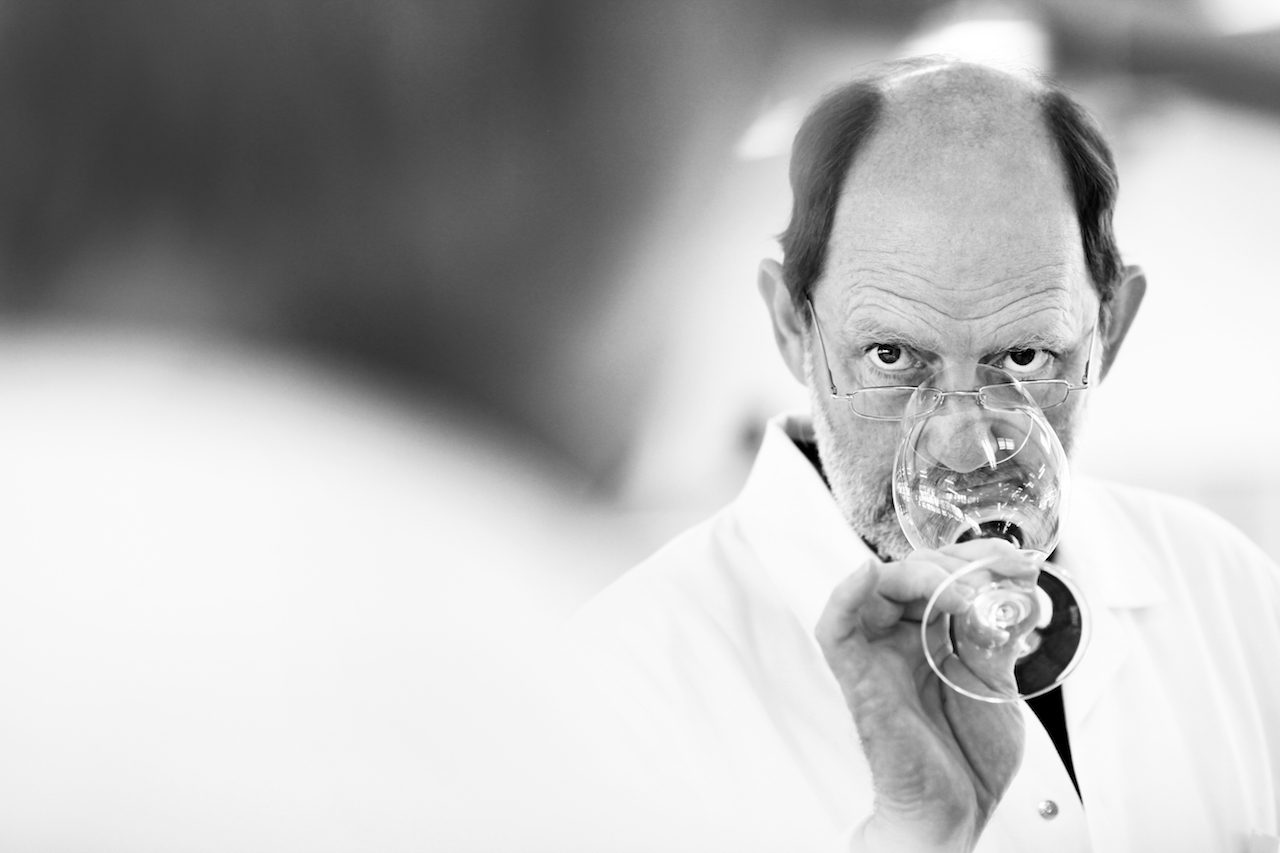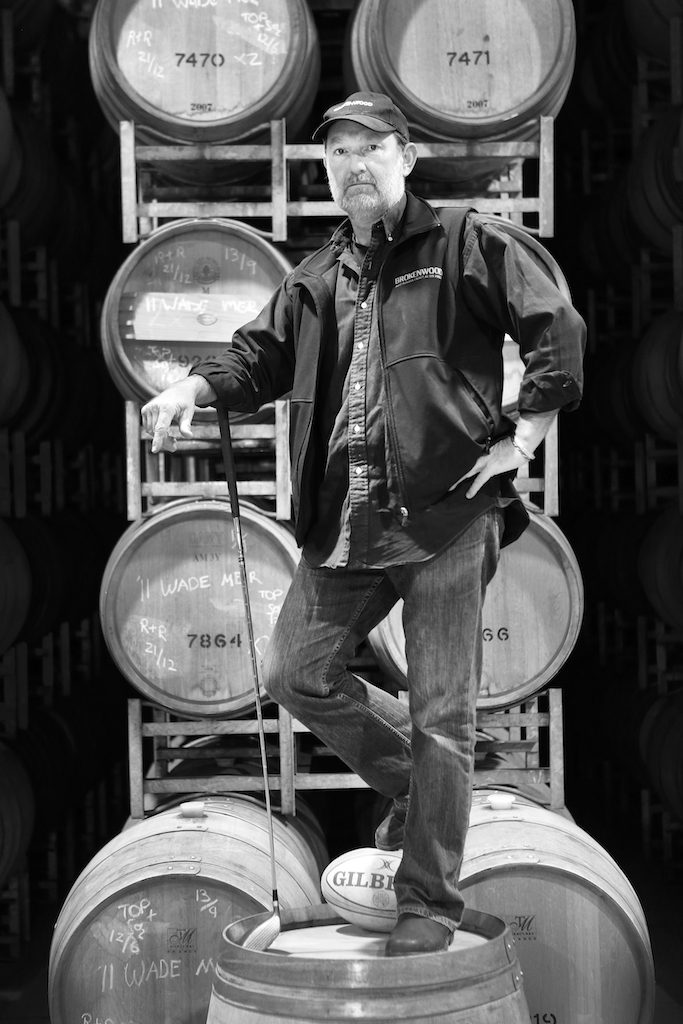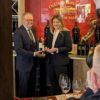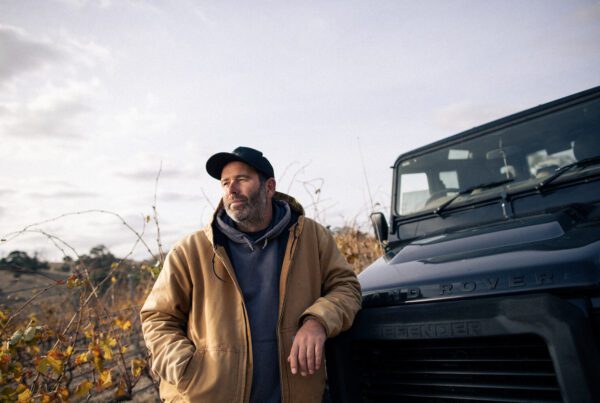
Brokenwood winemaker Iain Riggs has been named a Member of the Order of Australia (AM). To mark this achievement WBM has republished the cover story we did on Iain back in July 2012.
Words: James Howe
Photographs: Chris Elfes
At his core, Iain Riggs is an artist. If he’d been born in a city apartment he might have been a photographer or an architect (he thought seriously about the latter but, having grown up on sheep and wheat farms in South Australia, couldn’t reconcile himself to life behind a desk). “I suppose winemaking fulfils the side of you that was going to be an architect,” says Iain, Brokenwood managing director, chief winemaker and part-owner. He’s the force behind the brand’s flagship wine the Graveyard Shiraz, perhaps the Hunter’s most famous red. “You always strive for the best wine you possibly can. You’ve got to be constantly questioning what you’re doing and how the wine is, and getting other people to question. I think a winemaker who walks around his winery and every wine he tastes he says ‘that’s just terrific’ – that winemaker is doomed.”
Iain arrived at Brokenwood in 1982 to an unorthodox operation. A hobby project of (at the time Sydney solicitors) Tony Albert, John Beeston and James Halliday, Brokenwood was a melting pot of big ideas and bizarre antics. Legend has it the first haul of grapes was delivered to the winery in the back of Len Evans’ Bentley. “But they had a great sense of camaraderie – all pitching in and working together: you’d cook up a big feed, drink lots of great wine, and play poker until the early hours of the morning.”
Before joining Brokenwood, Iain had done time at the Waikerie Co-Op, Bleasedale and Hazelmere (where his 1982 Chardonnay snagged Best Wine of Show in McLaren Vale and earned him the title of Bushing King). In the 70s and 80s, Brokenwood was the kind of place budding winemakers dream about. With such industry greats as James Halliday, Len Evans, John Beeston and Nick Bulleid a part of the furniture, ideas were thick on the ground. “They taught me heaps,” says Iain. “It wasn’t so much in winemaking, but in winemaking through osmosis – they were my mentors in terms of great wines of the world. Len would always open the best wines he could and challenge people to taste wine and drink wine, enjoy wine.”
But Len Evans was seen as a mixed blessing at Brokenwood – when he was on the poker trail, the sight of his car on the driveway would send the workforce running. “When Len Evans would come up and stay at Rothbury Estate, he’d party till all hours and then jump in his car and come over here to see if he could con someone at poker,” says Iain. “The shareholders who were up would see the car come up the road and quickly turn the lights out – that way they wouldn’t end up losing all their money to him.”
On one memorable poker night, James Halliday had retired to bed early with a migraine. But getting up later to visit the loo, he was talked into being dealt a hand on his way back to bed. It was a good hand, so he stayed on betting until his three-of-a-kind was beaten by a flush, and his last few dollars ran out. “So he pushed himself back from the table,” says Iain. “And declared that that was the most expensive late-night piss he’d ever had.”
The social life remains a big part of the Brokenwood operation. Each year, a chef is hired for 10 weeks during vintage and the winery’s dinners have become a feature in the Hunter Valley. Winemakers from neighbouring wineries often invited to take part and it’s not unusual to have 25 people around the table. “It’s just a great time of year,” says Iain. “A lot of late-night parties, lots of naked people in vats plunging reds.”

But every life has its ups and downs, and Iain’s has been no exception. Tragically, last year his son Elias – adopted from Ethiopia as a five-year-old in 1996 – committed suicide. The promising young winemaker had done vintage in France and appeared to be happily working at Watershed Winery in WA when he took his own life. “His demons got to him,” says Iain. “We went through some pretty tough times with him in his mid-adolescence and we thought he’d worked his way through that. I still don’t know that I’ll ever cope with it.”
And there’s no denying the Hunter Valley can be a tough place to work. In 2008, heavy rains destroyed all of Brokenwood’s red grapes and most of its white grapes. This is not unusual for the region, which is infamous for its wild weather close to harvest time. “It’s expensive viticulture – you have to go to your shareholders and the board and say ‘sorry – we’ve just written off half-a-million dollars because we didn’t pick any fruit.’” So how does a winemaker cope with such volatility? “Stoically” says Iain with a wry laugh. “You just accept that it is what it is.”
But it’s not all dark clouds – this year Brokenwood was the only winery in the Hunter Valley to harvest all of its red grapes. This was achieved through a healthy dose of hard work – mostly in the form of laborious thinning and spraying – and a dash of careful strategy. “It’s a corny expression, but when the going gets tough, the tough get going – and that really does sum up what the winemakers here in the Hunter do,’ says Iain. “It’s what you deal with living and making wine in the Hunter Valley.”
Iain has seen tremendous change sweep through the region, driven by the changing fashions of the past three decades. Whereas in the past companies like Penfolds, Rothbury Estate, Lindemans and Orlando had homes in the Hunter Valley, today, most of the big brands have left. Even Orlando has recently put its biggest property – the largest single vineyard in the Hunter Valley – on the market. But Iain doesn’t spare any tears over this. His main regret is that the smaller wineries can’t command the advertising revenue formerly wielded by the big players. “Gone are the days when you used to open the newspaper and there’d be a full-page ad for Lindemans White Burgundy… but that’s been replaced by some very clever marketing that the new generation lads are doing,” he says. “The good thing is that all those companies have been replaced by smaller family operations who are making great Hunter wine styles – the likes of Andrew Margan, David Hook, Andrew Thomas, Mike De Iuliis.”
Iain hopes the change to these smaller boutique wineries will see the Hunter Valley fare shift to the premium end of the spectrum. “As Len Evans always said, the Hunter should have been always at the top end of the price scale – and I think it will eventually get there, because people are focussing on quality, smaller, single-vineyard wines and prices are going up accordingly,” he says.
Iain’s passion for quality wine feeds into an enthusiasm for wine shows. “I’m a big supporter of the wine shows, because they’ve dramatically improved wine quality in Australia,” he says. Industry players from around the country will be discussing wine showing at the upcoming Len Evans Tutorial reunion, and Iain will be leading the conversation. He would like to see wine shows set up to better engage consumers. His ideas include switching to the 100-point system, introducing more consumer-friendly show catalogues and launching a smartphone app to allow people to track their favourite brands at wine shows. “There’s a big disconnect between what we’re doing and what the consumers understand we’re doing,” he says. “(Wine showing) needs to be constantly tweaked. Like anything, we can’t just sit on our arses and say ‘it works.’”
Once again, it’s Iain the perfectionist talking – anyone who’s opened a bottle of Graveyard Shiraz recently would know him well.
What inspires you about Australian wine?
The grapegrowers and winemakers; innovative and focused but always tempered with a dash of laconic Aussie humility.
What disappoints you?
Personally – I’ve bottled some ordinary wines that I would rather not have. Thankfully there is always someone out there who drinks them. As an industry – again, the ordinary wines being bottled and sold overseas.
Any regrets at all?
Not using screwcaps 30 years earlier. It annoys me that we sold so much product that failed us and therefore we failed our consumers.
What’s the best wine you’ve ever made?
It’s a toss-up between ’86 Graveyard Shiraz (drank a superb bottle of ’86 GY Cabernet on Friday night), the 1982 Hazelmore Chardonnay and 1983 BW Semillon.
Who would be your ultimate dinner party guests?
Three blokes who are very important to me – the younger two sadly are no longer with us. My son, brother and father.
What do you enjoy about renovating houses?
Creating a great living space in a ‘shell’ that has served one purpose but can be transformed into another. Frustrated architect.
Best Pokolbin reds?
A player (not a winemaker) wasn’t allowed to leave the pub after the ’07 Grand Final. What to do? Go into the toilet, take all his clothes off and wander out to the bar. Soon got to leave.
Favourite book?
Catch 22. Must re-read it.
Favourite movie?
Wild Bunch. Redefined the Western.
Latest cover story













Recent Comments